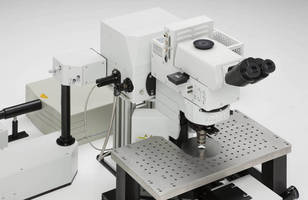Electromagnetic Field (EMF) Sensors / Detectors / Transducer
Photodetector delivers optimized fluorescence sensitivity.
Share:
Press Release Summary:

Suited for capturing faint fluorescence signals and minimizing laser power required to generate detectable signal, FV10MP-BXD-GAP features GaAsP coating on photoelectric surface of non-descanned detector unit that optimizes sensitivity. Noise is minimized via Peltier cooling, and design reduces effects of photobleaching and phototoxicity. System has two conventional multi-alkali PMTs for routine browsing of samples and two GaAsP PMTs for highly sensitive analysis of specific ROIs.
Original Press Release:
Fluorescence Sensitivity that Will Make You GaAsP
Olympus releases a new GaAsP non-descanned photodetector for highly sensitive photon detection and fluorescence imaging with the FluoView FV1000MPE
Hamburg - Olympus has released the new FV10MP-BXD-GAP photodetector for enhanced sensitivity when performing multi-photon fluorescence imaging. The new non-descanned detector unit is ideal for capturing very faint fluorescence signals and for minimising the laser power required to generate a detectable signal, making it the best choice for advanced life science research. Exceptional sensitivity is achieved by coating the photoelectric surface of the detector with Gallium Arsenide Phosphide (GaAsP), which offers superior quantum efficiency compared to conventional PMTs. In addition, noise is kept to an absolute minimum via the use of Peltier cooling, boosting signal-to-noise ratio. The detector unit also includes standard PMTs, allowing these to be used for identifying regions of interest (ROI) which can then be scanned using the GaAsP PMTs, maximising their lifetime. When used in combination with a member of the Olympus range of FluoView FV1000MPE multiphoton microscope systems, researchers can produce insightful images, even when using advanced irradiation techniques, low laser power or very faint fluorophores.
The new FV10MP-BXD-GAP non-descanned photodetector from Olympus has been designed to make the best use of every photon emitted by a sample. Efficient photon detection means that a wide range of biological processes can be investigated using fluorescently-tagged molecules expressed at physiologically relevant concentrations, even at levels that were previously too low to be detected using traditional multi-alkali PMTs. In addition, as a lower intensity of laser light is required to accurately detect each fluorophore, the power of the laser can be reduced. This minimises the effects of photobleaching and phototoxicity, thereby increasing the accuracy and biological relevance of results, especially for experiments performed over long time periods or requiring frequent laser light exposure.
The FV10MP-BXD-GAP is equipped with 2 conventional multi-alkali PMTs for the routine browsing of samples, and 2 GaAsP PMTs for the highly sensitive analysis of a specific ROI. Switching between the two types of detector is easy and fast, providing a hassle-free workflow. To further lengthen the lifetime of the GaAsP PMT, the system prevents any unnecessary exposure to ambient light such as room lighting or excessive fluorescence. The FV10MP-BXD-GAP can be purchased as part of a new FluoView system, or can be used to upgrade an existing setup, where it will provide the sensitivity required to produce high quality images, facilitate accurate photon detection and allow even deeper imaging via multiphoton microscopy.




